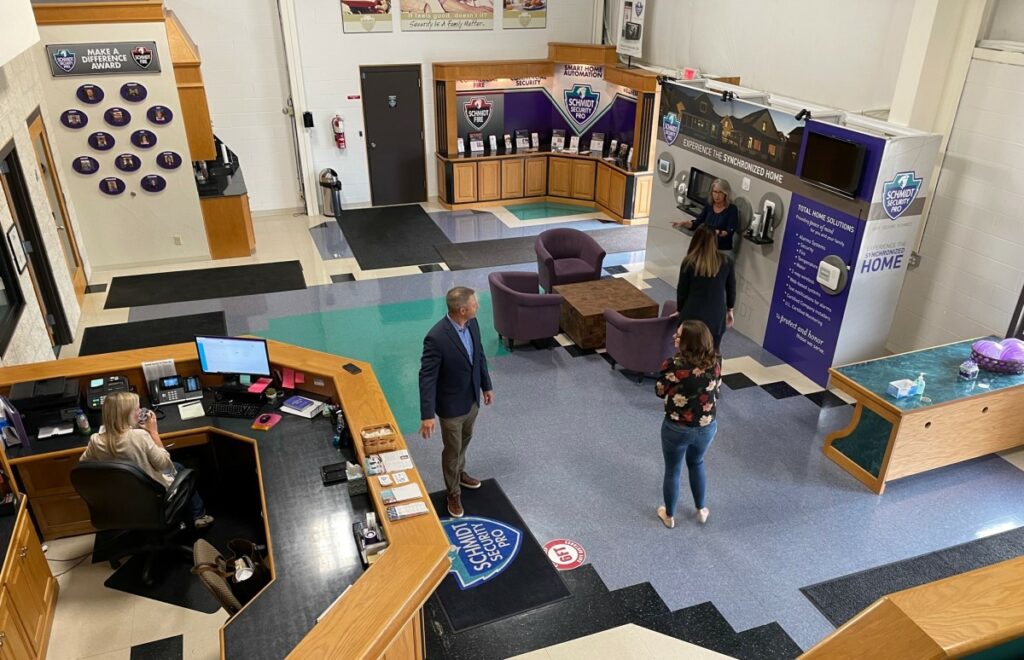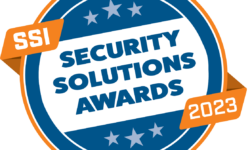How Schmidt Security Won the 2021 Police Dispatch Quality Award
Schmidt Security Pro implements its three-pronged EAP (education & training; attention & review; protocol & standards) program to thwart false alarms.

“You can’t understand someone until you’ve walked a mile in their shoes” is a variation on a well-worn, universal concept that is particularly apropos where the 2021 Police Dispatch Quality Award (PDQ) is concerned.
There’s a kind of poetic justice in that the latest representative for a program dedicated to promoting relationship building between the security alarm industry and law enforcement is a company founded by a former police detective. Launched by Bill Schmidt in 1976, Schmidt Security Pro is a full-service security and fire solutions provider based in Mansfield, Ohio.
During 2020-2021, the firm worked closely with its local city safety service director and alarm administrator as they revised the Mansfield Alarm Ordinance. Schmidt Security Pro representatives directed officials toward the Model Ordinance, best practices and fine structure provided by the Security Industry Alarm Coalition (SIAC) as a reference point during the drafts.
The updated ordinance specifies more accountability for alarm owners and providers alike — requiring companies to supply user training and documentation, and an escalated fine schedule for chronic false alarm offenders.
“We met with them in person and exchanged emails providing suggestions and feedback during the revision process, providing perspective from both an alarm installer and end-user standpoint,” says President/CEO Brian Schmidt, the company’s second-generation leader. “It’s a great honor to be the recipient of the 2021 PDQ award. I’m excited that our team is being recognized for the work they have done toward reducing false dispatches — and helping to positively impact our customers and community.”
Established by SIAC and Security Sales & Integration and endorsed by the Partnership for Priority Verified Alarm Response (PPVAR) and Installation Quality (IQ) program, the PDQ Award annually honors a security firm that best demonstrates a proactive, cooperative and successful effort in false alarm reduction strategies.
Now in its 16th year, the program’s mission is to raise industrywide awareness, promote partnering with responding agencies for public safety, motivate alarm companies to take action and provide workable models.
“Schmidt Security Pro reflects the commitment to excellence we look for when reviewing PDQ Award applications,” says SIAC Executive Director Stan Martin, a member of the SSI Industry Hall of Fame. “We congratulate Brian Schmidt and his team for their exceptional work addressing alarm dispatch reductions.”
Joining in to reveal more details about their outstanding operation are Schmidt Security Pro COO Ken Zahn, Director of Sales & Marketing Christen Dingess and Security Systems Group Manager Troy Bright.
What were the drivers in Schmidt Security Pro mounting a comprehensive false alarm reduction program? What makes Schmidt proactive rather than reactive in this area?
Brian Schmidt: Schmidt Security Pro recognizes as a professional security installer it is our responsibility to take the lead in false alarm reduction. One of the primary drivers was a local municipality that was in the process of revising their alarm ordinance.
We felt it was important to be part of the initiative to provide ideas and solutions focused on false alarm reduction. To provide the best insight, we reached out to industry organizations such as SIAC as well as other municipalities, alarm administrators and security dealers to assemble ideas on best practices.
Our company mission is “To positively impact our customers, co-workers and community.” Putting a stronger focus on reducing false dispatches and strengthening relations with law enforcement is in alignment with our company mission.

Schmidt Security Pro’s 35 associates serve a 15-county region in Central Ohio. The company provides integrated services to homeowners, businesses, schools, hospitals, banks, government agencies, manufacturing facilities and more.
Who are the primary people responsible for developing, implementing, fine tuning and maintaining the program? How was the mission accomplished organizationally?
Schmidt: Schmidt Security Pro’s EAP Program was developed as a result in our strategic team meetings as an initiative the company could take to reduce false alarms and improve the overall customer experience. This was an objective for 2020 that was shared with all team members. Different parts of the program were owned by the following teams, which also reveal the meaning of EAP acronym.
Education and training are the responsibilities of the technicians and our dedicated trainer to ensure that the customers are comfortable with their systems and know how to operate with competence. Attention and review falls on the customer service team to monitor and review the alarms. They address what caused an alarm and identify if additional training is needed or a service call is required to address a performance issue.
Protocol and standards is the responsibility of the management team. Company leadership evaluates solutions to ensure we are offering the optimal equipment to our customers. Additionally, management holds the team accountable to the standards of operation that we have in place for customer satisfaction.
14 PDQ Best Practices
1. Advertising, sales literature provide realistic expectation of alarm response
2. Salespeople explain permitting requirements, fees and fines
3. Use of Enhanced Call Confirmation (ECC, formerly ECV)
4. Contact customers after every false alarm
5. Track worst false alarm offenders and take action if needed
6. Instruct customer on verification process and keep call lists updated
7. Ongoing communications with customers
8. Installers have minimum NTS Level I or II training or equivalent
9. In-house training must be led by credentialed instructors
10. Customers thoroughly instructed on all system operations
11. Checklists used for installers and customers
12. Unique or additional initiatives (e.g. video verification)
What modifications of the plan had to be made along the way? What are some areas you would still like to see improvement?
Ken Zahn: We identified that a higher value needed to be placed on customer training than it had been given in the past. It was an area that needed more attention and we created a process to ensure all customers receive adequate training. This involved us dedicating a trainer to all new customers and making sure existing customers have access to training resources, such as quick-start guides, training videos, help desk support and onsite training if needed.
How costly of an undertaking was it; how did you budget and what is the ROI?
Zahn: We didn’t incur significant upfront costs other than additional time spent internally and with customers that will be recouped in customer satisfaction, customer longevity and reducing false alarms. The reduction in false dispatches creates community goodwill, which supports our reputation as a security leader in our market.
How difficult was it to get Schmidt’s personnel to conform to the policies and procedures?
Christin Dingess: Once we talked through the “why” we were putting more of a focus on training and reducing false dispatches it wasn’t very difficult. We provided resources for our technicians that supported the initiative and generated more buy-in. We developed quick-start guides for all our standard products so the customer has comprehensive information at their fingertips to know how to operate their new technology. This made it easier for the technicians to provide training as they had a step-by-step process to follow and leave-behind materials to help the customer after the installation and initial training.
How do you coordinate efforts between your installation/service and wholesale monitoring provider? What does each side bring to the table?
Troy Bright: Schmidt Security Pro partners with CMS to provide the central station monitoring services. CMS provides several tools that help our team manage false dispatches.
These include CMS’ Compass software that provides a dealer “dashboard” that includes critical real-time information to our internal team that allows us to identify and manage customer locations with repeat alarm issues. This software also allows our technicians to remotely view account history, individual zone alarms or trouble conditions, as well as immediately put systems in “test” mode prior to servicing any system.
Additionally, we have a close relationship with CMS where they regularly ask us to provide feedback and information related to the services and technology their dealers use.
Overall, CMS brings us the resources required to provide a high level of service including trained personnel, software, UL certifications, and redundant communications and power equipment — even redundant physical locations. All that comes without the extremely large capital expense that would otherwise be required. They do a great job of focusing on the 24/7/365 monitoring aspect of the business, which allows us to focus on the customer-facing installation and service side of the business.

Schmidt has invested in electronic ticketing software so all service requests are tracked electronically and can be managed in real-time. And all technicians use electronic tablets to receive and complete work orders and job tickets.
What have been the customer challenges implementing the plan? Have any problem accounts become more problematic?
Dingess: As mentioned, we have developed quick-start guides for all systems to get new customers started. This gives the customer a go-to resource for any initial questions or concerns and has been a tremendous help with our residential and small-business customers. However, for more complex customer environments there are varying needs and level of service required.
We have a dedicated systems trainer to coordinate training for multisite organizations with integrated systems. Overall, the feedback has been very positive because the customers appreciate the time spent on training and having the resources they need to answer questions or request service.
Also, we have a dedicated help desk to provide remote service that allows customers to get answers to their questions quickly and initiate a service request if needed. The help desk also supports our technicians by providing troubleshooting assistance when they are onsite without adequate resources. The help desk takes advantage of the real-time view of central station information with the CMS Compass software. We can easily identify system events or troubles as they are happening.
What have been the implementation challenges on the law enforcement side? How did you get their buy-in?
Schmidt: We have always worked to have a positive relationship with law enforcement. Before my father (Bill Schmidt) started the business in 1976 he was a police officer. I have several other family members involved in law enforcement, and [COO] Ken Zahn is a former sheriff’s deputy and investigator. So we understand the challenges a false dispatch creates, and strive to continue to find ways to lower false dispatch numbers.
Frequent communication with alarm administrators, 911 dispatchers, police department shift commanders, safety-service directors, police chiefs, etc. has helped us maintain overall good relations with law enforcement. From a larger perspective, the current trend toward reducing funding and an increased negative sentiment toward law enforcement point toward increased opportunities for providers of private security solutions.
Zahn: We believe police response is still a critical component of protecting the communities in which we live and work. Customers value having a timely response by law enforcement. Good, consistent communication with law enforcement addressing any concerns with customer false dispatches can go a long way toward maintaining police response.
How have the results meshed with your projections and expectations?
Dingess: The data from one local municipality shows a false dispatch reduction of almost 40% during the past 10 years. We feel it’s a combination of adopting industry standards such as Enhanced Call Confirmation and CP01, better technology, staff and customer training, as well as communications with customers and awareness that’s led to the improvement.
False alarm reduction also has a correlation with customer retention. Customers who are experiencing false alarms and consistent issues may become unhappy and look to make a change. We believe if we can identify these issues sooner, communicate with the customers and fix any issues better and faster we’ll have better customer retention.
How are advances in communications and other technologies affecting alarm management?
Bright: The advances in communication are helping us and our customers to have more remote access and control of their systems. This helps us better support our customers and provide additional solutions for service and support. It’s beneficial whenever we can avoid extra costs associated with going onsite.

At Schmidt, new employees participate in a structured onboarding process that involves spending time with different departments within the company to understand what everyone does and how
their job ties in with others.
Schmidt: The ability to remotely manage and make programming changes to alarm systems has been one of the biggest changes I’ve seen in the industry. When the PDQ program began 15 years ago, our only option was to put a tech in a truck and go onsite to determine what may be triggering an alarm, make changes to programming, etc. Today, we can see all aspects of system programming, user actions, trouble conditions, alarms, etc. remotely. We can also diagnose issues and often even make changes to a system that will address reasons for a false dispatch — without ever going onsite.
Also, the ability to communicate faster and in many different ways with our customers has helped to improve alarm management. Fifteen years ago, we would make a phone call and maybe use email to communicate with customers. Now, we communicate with customers in a variety of different ways including phone, email, text messaging, social media, video messages/video links, our website, etc. This provides various avenues for us to get the right information to the customer quickly — in the format that best suits their needs.
What about video verification as a tool to mitigate false alarms? Is this being provided by or investigated by Schmidt?
Zahn: As more cameras are deployed, they will definitely become a tool to help verify alarms. We currently have customers who receive video alerts when their system has an alarm. This gives the customer an opportunity to cancel the alarm with our central station. We’re also exploring scenarios where the CMS operator is sent video along with the alarm signal and has the opportunity to verify the alarm using the video.
This makes a lot of sense, however, some challenges include the cost of having video in every location alarm sensors are being used at a customer site, as well as the lack of broadband for a video feed in some remote areas we do business.
Schmidt: Technologies such as cameras with video analytics and improved outdoor detection solutions are becoming available and will provide us — and our customers — with improved options for detecting intruders and notifying law enforcement when there’s an actual threat while minimizing false triggers. We see where using these new technologies alongside much of the legacy technology will lead the way in continuing to reduce false dispatches for professional security companies.
Do you see DIY or MIY having an impact on false alarms?
Schmidt: In the grand scheme of things, DIY and MIY are fairly new concepts —professionals have been installing alarms for almost 150 years! When a system is not professionally installed there is more opportunity for errors that result in false alarms. I believe the recent influx of DIY and MIY options has led to new challenges for law enforcement and municipalities that include false alarms, managing alarm permits, slow response to equipment issues, etc.
What are some of Schmidt’s overall keys to its business and operations success?
Bright: The mission of Schmidt Security Pro is to positively impact our customers, co-workers and community. This is posted on the wall in each department and in other common areas of our building. Having this mission engrained in our daily operations ensures that our employees feel valued, our customers receive excellent service and we provide community support. Therefore, this mission drives the products we choose, the standards in which we operate and guides our decision-making processes.
Check out more behind-the-scenes images of Schmidt Security Pro in the slideshow.

If you enjoyed this article and want to receive more valuable industry content like this, click here to sign up for our FREE digital newsletters!

Security Is Our Business, Too
For professionals who recommend, buy and install all types of electronic security equipment, a free subscription to Commercial Integrator + Security Sales & Integration is like having a consultant on call. You’ll find an ideal balance of technology and business coverage, with installation tips and techniques for products and updates on how to add to your bottom line.
A FREE subscription to the top resource for security and integration industry will prove to be invaluable.










